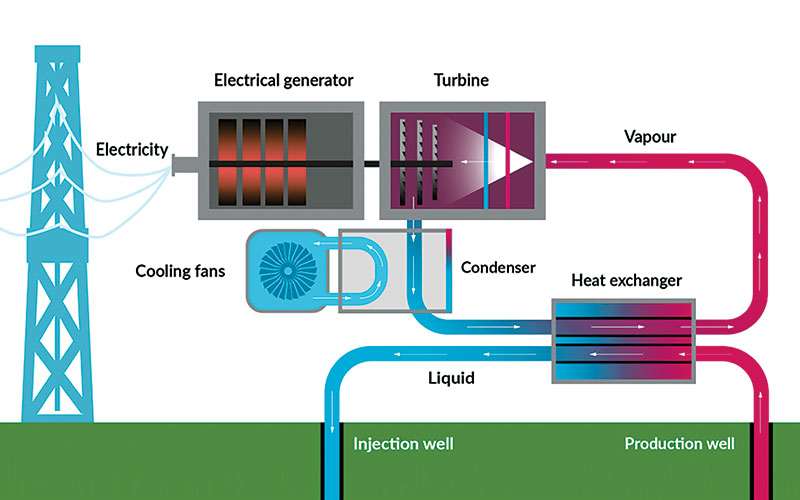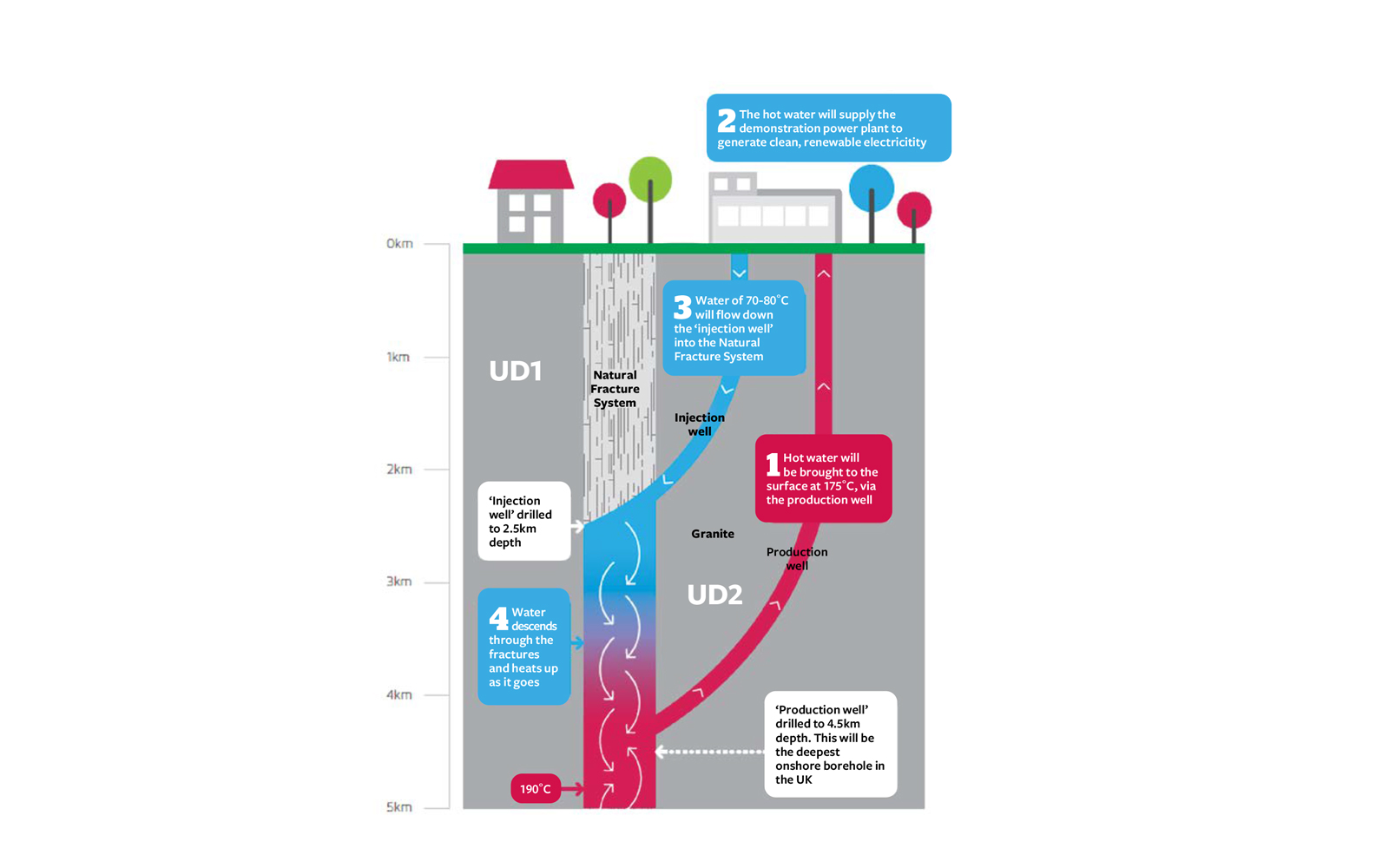Geothermal energy: a serious contender for sustainable heat and power
This year the UK will generate its first power from the heat beneath our feet. It is time to take geothermal seriously, says Dr Ryan Law at Geothermal Engineering Ltd

As countries and companies continue their push to reach net-zero targets, new and technologically innovative strategies in the energy sector will be more crucial than ever.
Despite strides in solar and wind power, their intermittent nature means we still need 24/7 baseload power generation, which is often reliant on carbon-intensive methods. Overcoming this is imperative if renewable sources are to supplant fossil fuels.
Geothermal: a clean baseload solution
The geothermal resource (heat and power) offers a consistent, zero-carbon renewable energy source. Harnessing the heat from deep beneath the Earth’s surface, geothermal power plants can generate electricity continuously, whatever the weather. This guarantees a constant supply of electricity to the grid –essential for balancing our power networks as we integrate increasing amounts of intermittent energy from wind and solar.
From ancient roots to modern innovation
Geothermal resource is nothing new: geothermal heat has been used since pre-Roman times, primarily for hot water supply. Electricity plants have been in operation for more than 100 years. Historically, major geothermal power producers include Italy, Iceland, the US and Indonesia. These nations predominantly developed power plants in areas of high heat flow, often where steam was readily available at the surface.
More recently, Africa (notably Kenya) and Turkey have begun tapping into their geothermal resources, resulting in rapid growth in these regions. In other parts of the world where geothermal resources are deeper, projects are now proliferating, with Germany notably increasing its investment in this sector.
The UK’s geothermal revolution
In the UK, Geothermal Engineering Ltd (GEL) has been targeting deeper resources.
The United Downs Geothermal Power project began in 2009, with site acquisition and planning commencing the following year. Initial funding agreements were secured in 2017, and by 2019, the drilling of two wells, 5,275m and 2,393m deep respectively, was successfully completed. Final production testing concluded in 2021, marking a significant milestone as the site produced geothermal steam in July – a first for the UK.
Construction of the plant started on the site at the start of 2024, and electricity generation is scheduled to commence in Q4 of this year, with the actual construction work set to finish in the summer.
The United Downs site is a ‘proof of concept’ and, in combination with the rest of the GEL portfolio, the company is targeting 5MWe of baseload electricity and 100MWh of heat energy by 2028. This will be enough to power and heat as many as 70,000 homes – an exciting reminder of just how important geothermal energy will be for the UK and the wider world as we strive to deliver on our commitments to reach key environmental goals.
Last year, the company was awarded three Contracts for Difference (CfDs) in the UK Allocation Round 5 process, a historic first for geothermal projects. These 15-year agreements, supported by the government, provide revenue stabilisation to protect renewable power generators and electricity buyers from market price fluctuations. The initial CfDs were awarded to the United Downs, Manhay and Penhallow projects – another exciting opportunity for the UK’s broader renewable energy landscape.
Geothermal lithium: powering clean transportation and sustainable industry
Geothermal power and heat are not the only benefits of all the hard work that has gone into developing these geothermal sites in Cornwall. During the well testing at United Downs, fluid samples were collected from around 5km underground. The company made an incredible discovery: a lithium concentration of approximately 340 parts per million, one of the highest recorded at any European commercial geothermal lithium project. With demand for electric vehicle (EV) batteries rising amid as cleaner transport options become more necessary, lithium is experiencing heightened demand.
Direct lithium extraction techniques are also more prevalent around the world due to it being a carbon-friendly process, which presents a huge advantage for the operation already in place at United Downs, as well as other sites under development in Cornwall. Lithium can be extracted from the hot geothermal brine produced as a natural by-product of the main baseload geothermal power and heat operation. GEL aims to produce as much as 12,000 tonnes of lithium carbonate equivalent per year by 2030, enough for 250,000 EV batteries for average-sized cars.
The biggest bonus is that the whole process is fuelled by zero-carbon geothermal power, as opposed to the environmentally damaging quarrying at many mines today.
Additionally, as lithium extraction is set to take place within UK borders, the country is poised to emerge as a dominant force in European and potentially global lithium production. This, combined with advances in geothermal energy generation, the creation of job opportunities, and the driving of business towards the south-west of England, makes us proud of our achievements – both in plotting a course towards a cleaner planet and reviving Cornwall’s ancient mining industry in a modern, safe and sustainable way.
Geothermal’s role in a green future
Geothermal mining opportunities are substantial, driven by the demand for baseload power, renewable heat and zero-carbon lithium. The skillset and supply chain required for deep drilling and project development are already strong in the UK due to the oil and gas industry. We expect to see an increasing number of projects developed over the next decade.
The United Downs project
This project near Redruth accesses Cornwall’s naturally heat-producing granite with two deep, directional wells: a 5,275m production well (the UK’s deepest onshore) and a 2,393m injection well. Geothermal fluid is extracted, and the heat is used to generate electricity in a power plant. It is then re-injected underground via the injection well to reheat


By Dr Ryan Law, Founder & CEO, Geothermal Engineering Ltd
Image credit | Geothermal Engineering






Follow us
Advertise
Free e-Newsletter